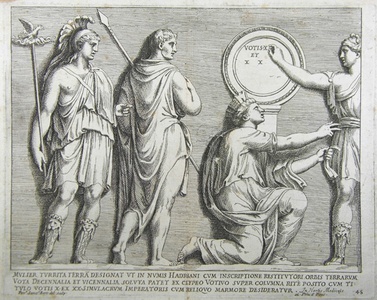| Method | Etching |
| Artist | Pietro Santi Bartoli |
| Published | Domenicus de Rubeis Chalcographus Anno MDCXCIII. Romae ad Templum Sa. Ma. de Pace, cum Privil. Summi Pont. et Licentia Superiorum [1693] |
| Dimensions | Image 188 x 250 mm, Plate 208 x 265 mm, Sheet 220 x 273 mm |
| Notes |
A depiction of a Roman relief panel of the goddess Roma commemorating the Decennalia and Vicennalia of the emperor Hadrian, Plate 45 from Bartoli's Admiranda Romanarum Antiquitatum (1693). Bartoli describes it as having been in the Medici Gardens. Hadrian (AD 76-138) was emperor of the Roman world between AD 117 and AD 138. Considered one of the 'Five Good Emperors' by Machiavelli, he was the adoptive son and successor of the emperor Trajan, a relative of his father. Both men hailed from Italica in southern Spain. A noted philhellene, Hadrian's reign witnessed a flourishing of art and culture. He was also a capable military strategist, spending much of his reign with the army. Although less militarily ambitious than his forebear, Trajan, his foreign policy consolidated Rome's borders, abandoning Trajan's conquests in Mesopotamia and building the famous wall in Britain that bears his name. However, the violent suppression of the Bar Kokhba revolt in Jerusalem made him deeply unpopular with Jewish communities across the empire. The Decennalia and Vicennalia were, respectively, celebrations of the tenth and twentieth year of an emperors reign. The celebrations had their origin in the actions of Augustus in 27 BC, who refused the supreme power in perpetuity in favour of a ten-year term. Decennalian celebrations of later emperors normally involved games, the minting of specific coinage, and the solemnization of the vota decennalia by the people. Because of the relatively turbulent nature of Roman imperial life, only a small number of emperors lived long enough to celebrate a vicennalia for their twentieth year, amongst them Augustus, Hadrian, Marcus Aurelius, Diocletian, and Constantine. The Admiranda Romanarum Antiquitatum ac Veteris Sculpturae Vestigia Anaglyphico Opere Elaborata ex Marmoreis Exemplaribus was one of a number of illustrated volumes on antiquarian subjects published by the prolific de Rossi family. The work featured 83 etched plates by the antiquarian and engraver, Pietro Santi Bartoli, depicting examples of Roman relief sculpture, all of which Bartoli had viewed and studied in the various papal and aristocratic collections across Rome. Like many of Bartoli's works, the plates of the Admiranda Romanarum Antiquitatum included commentary and notes by the celebrated antiquarian, Giovanni Pietro Bellori, with whom Bartoli enjoyed a long and fruitful academic partnership. The work was dedicated by the publishers to Cardinal Flavio Chigi, nephew of Pope Alexander VII and a member of the powerful Chigi family, who had died in September 1693, the same year as its publication. Cardinal Chigi had been a close friend of Bartoli's patron, Queen Christina of Sweden. His position in such a powerful papal family had also been beneficial to engravers and publishers, particularly those with an interest in classical architecture. Alexander VII had been one of the great 'builder' popes, whose term had endowed Rome with numerous churches, public fountains, gardens, and palazzi in the rococo style, as well as encouraging the excavation, documentation, and in some cases, restoration, of the monuments of the classical era. Many of the relief sculptures depicted in the Admiranda Romanarum Antiquitatum had been rediscovered in these excavations, and were quickly added to the collections of the Chigi family and their peers. Pietro Santi Bartoli (1635 – 7th November 1700) was an Italian draughtsman, architect, antiquarian, and engraver. Born in Perugia, Bartoli apprenticed with Jean Lemaire and Nicholas Poussin. Although he would give up painting following Poussin's death to focus on engraving, the classical scenes that were the speciality of Poussin and Lemaire were probably responsible for the young Bartoli's interest in classical subjects. In collaboration with the antiquarian Bellori and the publishers Giovanni and Domenico de Rossi, Bartoli produced a number of works documenting the art, architecture, history, and culture of ancient Rome. Of particular note are his series of 128 etchings depicting details of the frieze on the Column of Trajan, and a number of plates of Roman monuments after Giacomo Lauro that were published by Domenico de Rossi in his Romanae Magnitudinis Monumenta in 1699. Condition: Vertical centre fold as issued. Trimmed close to plate mark. Foxing to sheet and image. |
| Framing | unmounted |
| Price | £50.00 |
| Stock ID | 25357 |

